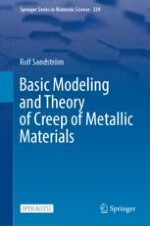Open Access 2024 | Open Access | Buch

Basic Modeling and Theory of Creep of Metallic Materials
verfasst von: Rolf Sandström
Verlag: Springer Nature Switzerland
Buchreihe : Springer Series in Materials Science
Open Access 2024 | Open Access | Buch

verfasst von: Rolf Sandström
Verlag: Springer Nature Switzerland
Buchreihe : Springer Series in Materials Science
This open access book features an in-depth exploration of the intricate creep behavior exhibited by metallic materials, with a specific focus on elucidating the underlying mechanical properties governing their response at elevated temperatures, particularly in the context of polycrystalline alloys. Traditional approaches to characterizing mechanical properties have historically relied upon empirical models replete with numerous adjustable parameters, painstakingly tuned to match experimental data. While these methods offer practical simplicity, they often yield outcomes that defy meaningful extrapolation and application to novel systems, invariably necessitating the recalibration of parameters afresh.
In stark contrast, this book compiles a compendium of models sourced from the scientific literature, meticulously crafted through ab initio methodologies rooted in fundamental physical principles. Notably, these models stand apart by their conspicuous absence of adjustable parameters. This pioneering effort is envisioned as a groundbreaking initiative, marking the first of its kind in the field. The resulting models, bereft of arbitrary tuning, offer a level of predictability hitherto unattained. Notably, they provide a secure foundation for ascertaining operational mechanisms, contributing significantly to enhancing our understanding of material behavior in high-temperature environments.
This open access book is a valuable resource for researchers and seasoned students engaged in the study of creep phenomena in metallic materials. Readers will find a comprehensive exposition of these novel, parameter-free models, facilitating a deeper comprehension of the intricate mechanics governing material deformation at elevated temperatures.